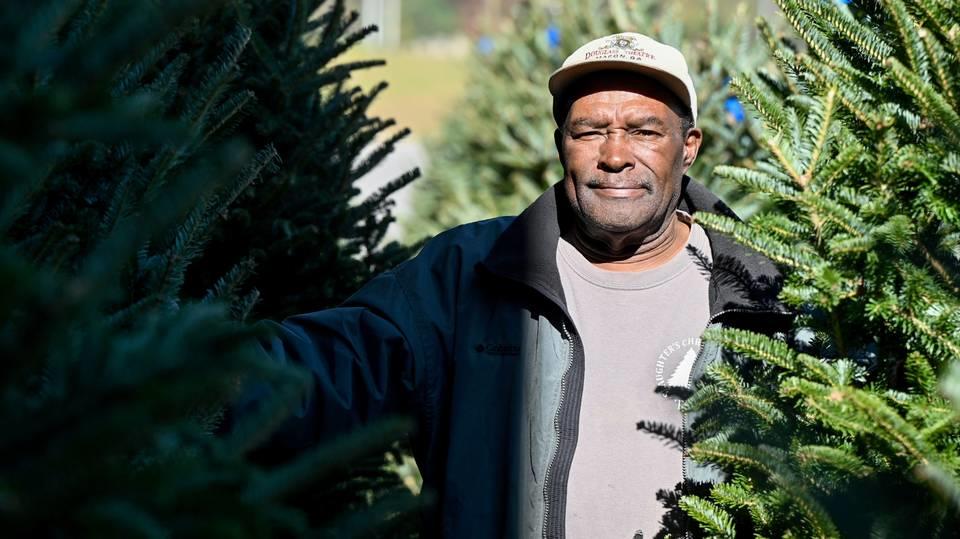
Caption
Larry Stephens has been working for Slaughter’s Christmas Trees at the Macon State Farmers Market since 1980.
Credit: Jason Vorhees/The Telegraph

Larry Stephens has been working for Slaughter’s Christmas Trees at the Macon State Farmers Market since 1980.
In late fall each year for the past half-century, beneath 100-yard-long, metal-roofed sheds at the Macon State Farmers Market, a propped-up forest of fresh-cut Christmas trees has burgeoned and gradually, by mid-December, vanished before Greg Slaughter’s eyes.
Or so he has hoped.
The 7,500 or so Fraser firs that he and his family truck in from North Carolina and Virginia populate what may be the largest retail-sales lot for live Christmas trees in the region.
Holiday fantasies of reindeer and sugar plum fairies aside, live (or once-living) Christmas trees don’t just fly off the lot. Contrary to what you might think, they don’t always sell themselves.
While a survey this year by the American Christmas Tree Association showed that 94% of consumers planned to decorate trees in their houses, roughly three-quarters of them prefer artificial trees.
Slaughter figures that in recent decades fake trees, as they become more electronically elaborate and lifelike, have chopped into the live-tree market.
“I don’t know if anybody could tell you how much,” he said. “It’d be a guess.”
Slaughter, 54, oversees Slaughter’s Christmas Trees, a Laurens County company founded by his father. He employs a seasonal crew of about 20 and has sales lots in Dublin and Stockbridge.
He now mostly sell Fraser firs, the small-needled favorite. The firs, for some vendors at least, have overtaken the once more common Leyland cypress in popularity.
Though artificial Christmas tree may come with high-tech lights and no-mess needles, what they cannot offer is the sappy, real-tree scent. Not to mention the sometimes sappier and unknown adventures that can come with picking one out or cutting one down at a farm and hauling it home.
Take the customer Slaughter recalls who bought a full-bodied, 9-footer that was maybe as “wide as a truck.” The customer, a woman, wanted it delivered and placed in front of a bay window.
“We get over to her house,” Slaughter recalled the other day, “and she’s got 7-foot ceilings.”
He told the woman, “This ain’t gonna work. The tree’s 2 feet too tall.”
“Just cut a little bit off the top and a little bit off the bottom,” she suggested, “and wedge it between the floor and the ceiling.”
So wedge it he did. The woman didn’t need a stand to hold it in place. The thing stood on its own. Stuck.
“We left her with it,” Slaughter said, “and she was happy.”
One of Slaughter’s longtime employees has been with the company since 1980.
Each season beginning around Thanksgiving, Larry Stephens has helped sell, lug and load trees for customers.
“I have sold people trees and then sold their children trees,” Stephens, 67, said. “Then I turned around and sold their children’s children trees. I just like the public.”
Stephens, who works at the service counter at a nearby automobile dealership, got his start with the Slaughters when he left his day job one afternoon. He drove across Eisenhower Parkway to the Farmers Market and bought a couple of trees. He tied them to the top of his purple station wagon. He sold the trees on the street, at a markup, and the next day he returned to buy more.
Slaughter, a teenager at the time, sensed Stephens’ sales talent
“He was getting the stuff we couldn’t sell and then going and selling it,” Slaughter recalled.
“Then they told me,” Stephens said, “they weren’t selling me another tree unless I came to work for them.”
When he first started, Stephens strode the lot sporting a Santa Claus T-shirt and red hat. These days, when it’s chilly, he bundles up in a heavy coat and a baseball cap.
He has seen marital strife unfold around the Christmas trees there, husbands and wives feuding over firs, fussing about fits and shapes and all manner of evergreen domestic discord.
On a recent afternoon, a couple argued about how much to spend on a tree. (The prices start at about $65 for 6-foot trees and go up from there to about $175 for 10-footers.)
Whatever the cost was, the wife insisted on buying.
“Well, I’m gonna leave,” the husband said, and took off.
The wife, in her own car, had Stephens tie the tree to the roof.
Other patrons, it seems, have other issues. Some take forever to select a tree.
Stephens, who has been around the business so long that he was interviewed for a local newspaper article about tree sales in 1997, said at the time that some spend two or three hours browsing the boughs.
“They say how ‘this one’s too big, this one’s too small.’ Got to be just right,” Stephens said in that Telegraph write-up 26 years ago. “I just got rid of a guy. Been here three hours. I just gave him a tree, said, ‘Go.’”
This story comes to GPB through a reporting partnership with The Telegraph.